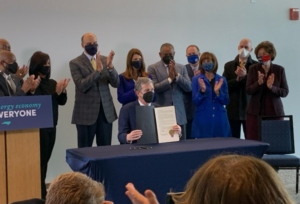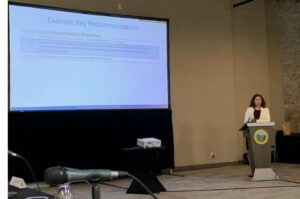NC Clean Technology Center Supports Next Steps Towards a Clean, Equitable Economy in North Carolina

North Carolina, along with the rest of the United States, is poised to make substantial advancements in the development and adoption of clean energy technologies in 2022. Only seven days into the new year, Governor Roy Cooper signed Executive Order (EO) 246, setting ambitious targets to mitigate climate change, including the reduction of statewide greenhouse gas emissions by at least 50 percent over 2005 levels by 2030 and net-zero emissions no later than 2050.
EO 246 builds on a wave of legislative activity in NC near the end of 2021. In October 2021, North Carolina increased targets set by the state’s renewable energy standards to 100 percent of electricity sales from carbon-neutral generation by 2050, a major increase from the previous target of 12.5 percent of sales from renewable generation by 2021.
As North Carolina identifies a pathway towards carbon neutrality and a sustainable economy, the NC Clean Energy Technology Center (NCCETC) at NC State University is actively working to advance the development and adoption of clean energy technology in governments, academia, industries and non-profit communities. Since it was established in 1987, NCCETC has grown into a state agency respected for its assistance to the burgeoning clean technology sector in NC, providing expertise and knowledge from a diverse group of staff members.
Preparing a North Carolina Clean Transportation Plan (NCCTP)
Executive Order 246 also takes steps to encourage and prepare for North Carolina’s transition to a clean transportation future, calling for an increase in registered zero-emission vehicles (ZEVs) to at least 1,250,000 by 2030. The Order instructs the NC Department of Transportation (NCDOT) to develop a Clean Transportation Plan (NCCTP) with a list of actionable policy and programmatic efforts to rapidly decarbonize the North Carolina transportation sector.
“This new order aims for aggressive decarbonization, and cleaning the grid and electrifying transportation is the best way to reduce overall emissions,” explained NCCETC’s Executive Director, Steve Kalland. Kalland is serving on a newly formed NCCTP Advisory Committee that is beginning to meet this month to provide input and guidance for the strategic objectives of the NCCTP. NCCETC will also help engage stakeholders during the process of developing a plan to support North Carolina’s transition to an equitable, clean transportation system. The transportation sector is the leading greenhouse gas emitting sector in NC today, contributing large amounts of harmful pollutants to the environment which pose serious health risks including asthma, lung disease and various other cardiac and respiratory diseases.
 The Clean Transportation program at NCCETC is also hosting a Clean Transportation Demonstration Day on March 29, 2022 in support of Governor Cooper’s executive orders. The Demonstration Day at the NC Highway Patrol Training and Driving Facility will give state and local government agencies across the state the opportunity to drive various alternative fuel and electric vehicles and receive information and procurement assistance for them.
The Clean Transportation program at NCCETC is also hosting a Clean Transportation Demonstration Day on March 29, 2022 in support of Governor Cooper’s executive orders. The Demonstration Day at the NC Highway Patrol Training and Driving Facility will give state and local government agencies across the state the opportunity to drive various alternative fuel and electric vehicles and receive information and procurement assistance for them.
Powering the Grid On and Off the Coast
North Carolina is well-positioned to participate in the rapidly growing offshore wind industry with the second highest offshore wind net technical energy potential in the United States. The Bureau of Ocean Energy Management (BOEM) has identified several areas off the coast of North Carolina particularly suited for offshore wind facilities: Kitty Hawk, Wilmington-West, and Wilmington-East.

“Offshore wind development is a great investment for North Carolina- it has the potential to create jobs for generations to come,” stated Kalland, who recently became a member of the new North Carolina Taskforce for Offshore Wind Economic Resource Strategies, or NC TOWERS. The Taskforce will provide expert advice to Governor Cooper and state policymakers on ways to advance offshore wind energy projects.
Governor Cooper first established the Taskforce in June 2021 with Executive Order 218, affirming North Carolina’s commitment to offshore wind power as the state transitions to a clean energy economy. The Order also establishes offshore wind development goals of 2.8 gigawatts (GW) off NC’s coast by 2030 and 8.0 GW by 2040.
 EO 218 directs actions to help North Carolina secure the jobs and economic development associated with the industry’s estimated $140 billion investment over the next 15 years to develop projects from North Carolina up the Atlantic Coast. NCCETC has been working with the NC Department of Commerce for the last several years to study the economic development, supply chain and workforce opportunities offered by the East Coast offshore wind industry.
EO 218 directs actions to help North Carolina secure the jobs and economic development associated with the industry’s estimated $140 billion investment over the next 15 years to develop projects from North Carolina up the Atlantic Coast. NCCETC has been working with the NC Department of Commerce for the last several years to study the economic development, supply chain and workforce opportunities offered by the East Coast offshore wind industry.
“It’s an exciting time to work in clean energy,” Kalland said. “We’re seeing a convergence of clean energy technologies, largely driven by discussions of grid resilience in our region.”
For a coastal state like North Carolina, worsening weather events like hurricanes are causing longer and more frequent power outages from downed power lines and blocked roads. Major weather-related power outages are estimated to cost the United States $25 to $70 billion annually.
 High wind and flooding are critical threats to North Carolina’s grid. Above ground electric wires are susceptible to falling trees and limbs and many roads become impassable due to rising water. During and after Hurricane Florence in September 2018, New Hanover County faced several vulnerabilities due to the interdependencies of systems with electric power. Across the county, 193 miles of internal roads were impassable, communication towers failed and back-up generators were incapacitated from flood waters.
High wind and flooding are critical threats to North Carolina’s grid. Above ground electric wires are susceptible to falling trees and limbs and many roads become impassable due to rising water. During and after Hurricane Florence in September 2018, New Hanover County faced several vulnerabilities due to the interdependencies of systems with electric power. Across the county, 193 miles of internal roads were impassable, communication towers failed and back-up generators were incapacitated from flood waters.
North Carolina received a $300,000 competitive award from the U.S. Department of Energy (DOE) in 2019 for a joint project by the NC Department of Environmental Quality (NCDEQ), UNC Charlotte’s Energy Production and Infrastructure Center (EPIC) and NCCETC. The two-year project, “Planning, an Affordable, Resilient, and Sustainable Grid (PARSG) in North Carolina,” examined storm-related impacts and costs and benefits of investments in grid resiliency as recommended in the NC Clean Energy Plan.
NCCETC partnered with NHC to conduct resiliency analyses of local facilities as part of the PARSG project. Facilities in NHC were screened for potential solutions which could ensure a reduction in the cumulative hours customers are without power. These solutions lie in grid modernization and distributed energy resources that can maintain critical operations and functions during any disruptive event.
According to NCCETC’s Christina Kopitopoulou, Senior Project Manager for the Clean Power & Industrial Efficiency (CPIE) program, one of the facilities that will undergo the resiliency analysis is a Wastewater Treatment Plant. “We are evaluating the viability of a combined heat and power (CHP) system which would generate power and useful thermal energy from gas captured during the anaerobic digestion process”.
Critical facilities, from the agricultural industry to hospitals and shelters for refuge can rely on CHP to withstand long, multi-day outages to keep essential services operational. CHP systems have the ability to island from the grid to keep critical loads operational when the grid goes down.